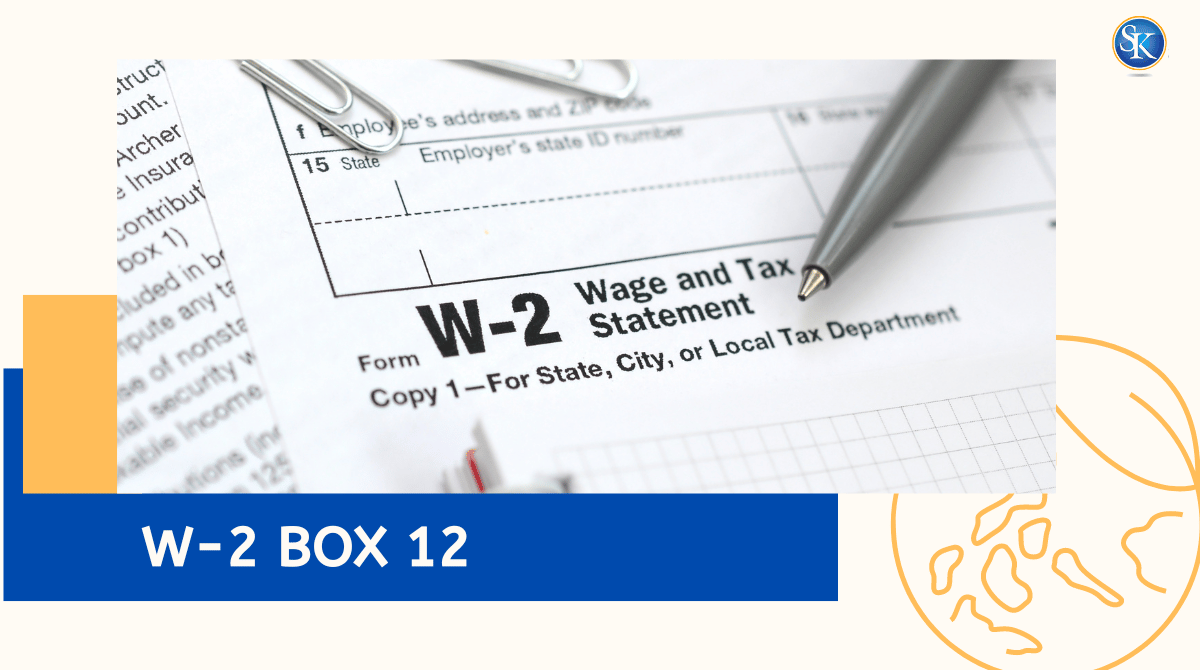
What the Form W-2 Box 12 Codes Mean | Instructions for Form W-2
When you get your W2 during tax season, Box 12 might look confusing. It contains small letter codes that represent retirement contributions, benefits, or other taxable items. Understanding these codes helps you file your tax return correctly and avoid losing refunds or overpaying tax. In this guide, we’ll explain what W2 Box 12 means, what each code stands for, and how to use this information when filing your 2026 tax return.
How to check federal tax refund status
What is W2 Box 12?
W2 Box 12 is where employers report extra pay items or benefits that are not shown elsewhere on the form. Each entry has a code and a dollar amount. These codes can include 401(k) contributions, taxable life insurance, or health plan costs. Understanding what each code means helps you check your tax return for accuracy.
Read more about W-2 Box 14 codes
How to Read W2 Box 12 Codes
Each code in W2 Box 12 has a specific meaning. You may see one or several codes depending on your job benefits. Use this list to find what applies to you when reviewing your W2 for 2026.
Book a free consultation with us
|
Code |
What It Means |
Description |
|
A |
Uncollected Social Security tax on tips |
Tax not collected on your tips. |
|
B |
Uncollected Medicare tax on tips |
Medicare tax not collected on tips. |
|
C |
Group-term life insurance over $50,000 |
Employer-paid life insurance over $50k is taxable. |
|
D |
401(k) contributions |
Pre-tax money you added to your 401(k). |
|
E |
403(b) contributions |
Pre-tax contributions for school or non-profit employees. |
|
F |
SEP plan contributions |
Employer pension plan deposits. |
|
G |
457(b) plan contributions |
Deferred compensation plans for government jobs. |
|
H |
501(c)(18) plan contributions |
Tax-exempt organization retirement contributions. |
|
J |
Nontaxable sick pay |
Sick pay not taxed. |
|
L |
Business expense reimbursements |
Work expenses your employer reimbursed. |
|
P |
Moving expense reimbursements |
Tax-free moving costs for Armed Forces. |
|
Q |
Combat pay |
Tax-free military income. |
|
T |
Adoption benefits |
Employer-paid adoption assistance. |
|
V |
Stock option income |
Earnings from exercising stock options. |
|
W |
Health Savings Account contributions |
Employer HSA deposits. |
|
AA |
Roth 401(k) contributions |
After-tax Roth contributions. |
|
DD |
Cost of employer health insurance |
Total cost of your health plan, not taxable. |
Why W2 Box 12 Matters
W2 Box 12 shows benefits and contributions that affect your taxes. Some codes reduce taxable income, while others report benefits that are only informational. For example, Code D (401k) helps you save on taxes now, while Code DD simply reports your health plan’s total cost.
How to Use W2 Box 12 When Filing Taxes
-
Check which codes appear in Box 12 on your W2.
-
Match each code using the IRS chart or your employer’s guide.
-
Add those figures to your tax software or give them to your accountant.
-
Confirm whether the code qualifies for deductions or credits.
Example: If your W2 shows Code W, that amount goes on your HSA deduction line in Form 8889.
Mistakes to Avoid with W2 Box 12
-
Ignoring Box 12 or skipping a code entry
-
Entering wrong amounts into tax software
-
Forgetting to claim deductions for 401(k) or HSA contributions
-
Misreading codes that look similar (like D vs. DD)
How SK Financial CPA Helps You Understand W2 Box 12
At SK Financial CPA, we review thousands of W2s every year and often find Box 12 mistakes that cost clients hundreds in missed refunds. For example, we’ve helped clients recover money by fixing errors in codes like D (401k) and W (HSA).
With over 24+ years of experience and 17,000 satisfied clients, our team ensures your W2 is read correctly and every benefit is claimed. Book a free consultation today and let us review your W2 before you file.
Conclusion
W2 Box 12 might look small, but it holds big details about your taxes. Knowing these codes helps you report income correctly, claim deductions, and avoid mistakes. Understanding it now can save you time and money when you file your 2026 tax return.
FAQs
1. What does W2 Box 12 show?
It lists special types of income or benefits like 401(k) or HSA contributions.
2. Do all employees have codes in Box 12?
No, only if your employer offered certain benefits or taxable items.
3. Is every amount in Box 12 taxable?
No, some codes are informational only, like Code DD for health insurance.
4. What if my W2 Box 12 has multiple codes?
Each code has a separate meaning. Use the IRS chart to check what each one represents.
5. Can I file without understanding Box 12?
You can, but it’s risky. Misreading a code can change your refund or tax owed.
Follow SKFinancial on Facebook / Twitter / Linkedin / Youtube for updates.












